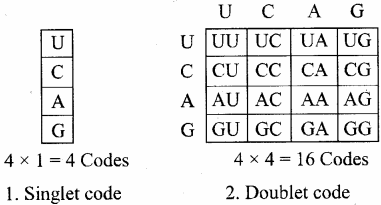Messenger RNA encodes a genetic message for protein synthesis which is decided by the DNA, as mRNA is transcribed by the DNA. The genetic message in mRNA is in the form of a sequence of nucleotides (bases). A specific sequence of nucleotides in mRNA specify one amino acid which is called as codon. The base sequence in tRNA that combines with codon is called as anticodon. The sequence of the nucleotides (bases) in mRNA that code 20 amino acids is called as genetic code. There are four types of nucleotides (bases) in mRNA and their arrangement code 20 amino acids.
Initially, singlet codon concept was considered which means one base (mucleotide) codes one amino acid. It gives only 4 genetic codes [4 x 1⇒ 4] which are very less to code 20 amino acids, hence discarded. Lateron, doublet codon concept was considered in which two nucleotides code one amino acid. This gives 16 genetic codes [4 x 4 ⇒16] which are not sufficient to code 20 amino acids, hence discarded.
Triplet Genetic Code:
Crick, Brenner et al. first demostrated that codons consist of three bases. Marshall Nirenberg and Heinrich J. Mathaei (1961) where the first to reveal the nature of a codon. According to triplet codon concept, three nucleotides (base) code one amino acid. It gives 64 genetic codes [4 x 4 x 4 = 64] which are more than enough to code 20 amino acids.
Holley, Khorana & Nirenberg studied all the 64 genetic codes, for this work they were awarded Nobel prize of 1968 in medicine/physiology. Nirenberg worked with Leder & determined 54 codons but Leder was not given the Noble prize.
